Is Dark Honey Safe to Eat
Dark honey is indeed safe to eat and offers numerous health benefits. It's packed with antioxidants, minerals, and enzymes that support your overall well-being. The darkness comes from the nectar source, not harmful compounds. You'll find varieties like buckwheat, manuka, and chestnut honey, each with unique flavors and properties. Dark honey has a lower glycemic index than refined sugar, making it a healthier sweetener option. While it's generally safe, infants under 12 months should avoid it due to botulism risk. Store it properly in airtight containers to maintain its quality. By understanding its origins and characteristics, you'll appreciate dark honey's true value.
This post may contain affiliate links. If you make a purchase through these links, I may earn a commission at no additional cost to you. Additionally, portions of this post may be generated using artificial intelligence (AI) technology. While we strive for accuracy, please be aware that AI-generated content may not always be perfect and should be fact-checked when necessary.
The Spatula Scoops
- Dark honey is generally safe to eat and offers numerous health benefits due to its high antioxidant content.
- The darkness of honey reflects its floral source and mineral content, not harmful compounds or toxicity.
- Proper storage in airtight containers and quality control measures ensure the safety of dark honey for consumption.
- Individuals with specific health conditions, such as diabetes or pollen allergies, should exercise caution when consuming dark honey.
- Dark honey is unsafe for infants under 12 months due to the risk of botulism.
What Makes Honey Dark
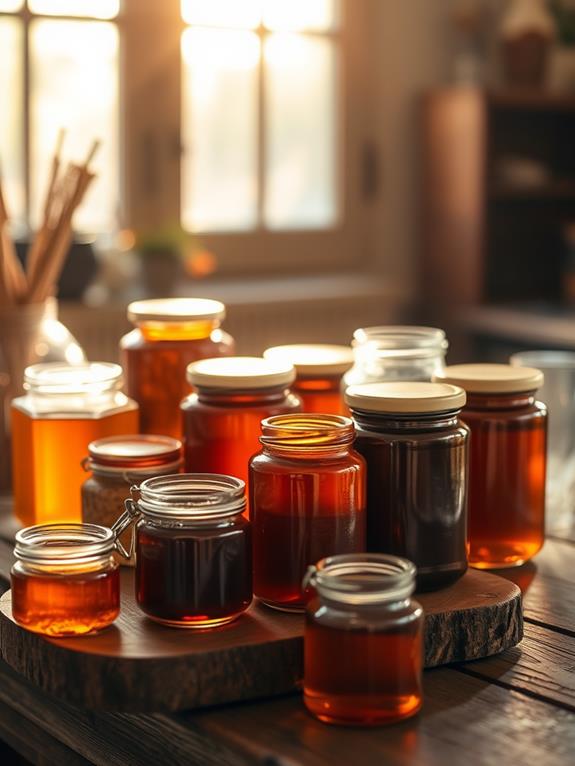
What Makes Honey Dark
The color of honey is a telltale sign of its origin and composition. When you're looking at dark honey, you're actually seeing the result of several factors that influence its hue. The primary contributor to honey's darkness is the type of nectar source the bees collect from. Honey from flowers like buckwheat, manuka, or chestnut tends to be darker than honey from sources like clover or acacia. Additionally, the processing methods used by beekeepers can vary greatly, much like how different stainless steel materials impact the performance of kitchen products, affecting the final color of the honey.
Another factor that affects honey's color is the presence of minerals. Dark honey often contains higher concentrations of minerals like iron, copper, and manganese, which can contribute to its deeper shade. The climate and temperature during honey production also play a role. Warmer temperatures can lead to darker honey due to a process called the Maillard reaction, where sugars and amino acids interact.
Age is yet another determinant. As honey sits, it naturally darkens over time. This process, known as oxidation, occurs when the honey is exposed to air and light. Finally, the processing methods used by beekeepers can influence the final color. Minimal filtering allows more pollen and propolis to remain, often resulting in a darker product.
Types of Dark Honey
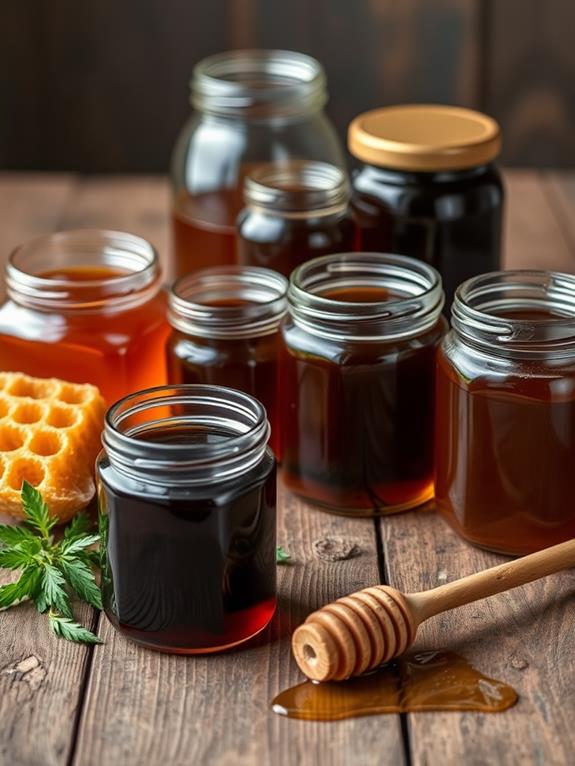
Understanding the factors that influence honey's color leads us naturally to explore the various types of dark honey available. You'll find that dark honey comes in several varieties, each with its unique characteristics and flavor profile. Here's a table showcasing some popular types of dark honey:
| Honey Type | Color | Flavor Profile |
|---|---|---|
| Buckwheat | Very dark brown | Strong, malty |
| Manuka | Dark amber | Earthy, herbaceous |
| Chestnut | Dark amber to brown | Bold, slightly bitter |
| Avocado | Dark amber | Rich, buttery |
| Wildflower | Amber to dark amber | Varied, complex |
When you're looking for dark honey, you'll often encounter these varieties. Buckwheat honey, with its molasses-like color, offers a robust flavor that's perfect for baking. Manuka honey, prized for its potential health benefits, has a distinctive taste that's not overly sweet. Chestnut honey's bold flavor might surprise you, while avocado honey's smooth, buttery notes can be a delightful addition to your culinary repertoire. Wildflower honey's color and taste can vary depending on the flower sources, making it an exciting option for honey enthusiasts.
Nutritional Profile of Dark Honey

Often overlooked, dark honey's nutritional profile sets it apart from its lighter counterparts. You'll find that dark honey is packed with antioxidants, particularly flavonoids and phenolic acids. These compounds help protect your body against oxidative stress and inflammation, much like the beneficial properties found in hemp milk. Dark honey also contains higher levels of minerals like iron, zinc, and manganese compared to lighter varieties.
When you consume dark honey, you're getting a good dose of vitamins, including small amounts of vitamin C, riboflavin, and niacin. It's worth noting that dark honey has a lower glycemic index than refined sugar, meaning it won't cause rapid spikes in your blood sugar levels. This makes it a potentially better option for those watching their glucose intake.
Despite its sweetness, dark honey isn't just empty calories. It contains amino acids and enzymes that can aid in digestion and support your immune system. However, it's important to remember that honey is still high in calories and should be consumed in moderation. While dark honey offers more nutritional benefits than its lighter counterparts, it's not a substitute for a balanced diet.
Potential Health Benefits
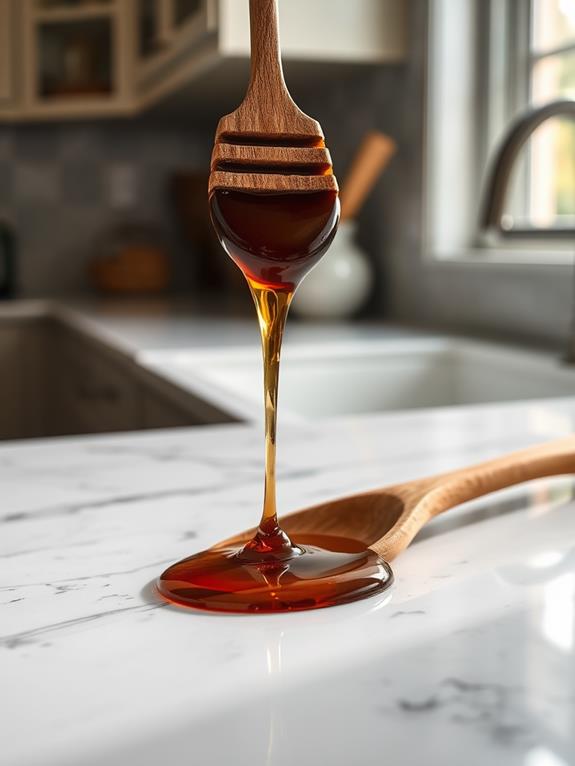
Several potential health benefits come with consuming dark honey. You'll find that it's rich in antioxidants, which help protect your cells from damage caused by free radicals. These antioxidants, particularly flavonoids and phenolic acids, may reduce your risk of chronic diseases like heart disease and certain cancers. Similarly, the health benefits of natural substances can also be seen in products like matcha, which is known for its own high density of antioxidants.
Dark honey also possesses antibacterial properties, making it useful for wound healing and fighting infections. You might even find it effective in soothing a sore throat or suppressing coughs. Its natural enzymes can aid in digestion, potentially easing gastrointestinal discomfort.
Additionally, dark honey's lower glycemic index compared to refined sugar means it won't spike your blood sugar as quickly. This makes it a better sweetener option for those managing diabetes or watching their sugar intake. Some studies suggest that dark honey may improve cholesterol levels, potentially lowering LDL (bad) cholesterol while increasing HDL (good) cholesterol.
Safety Concerns and Misconceptions
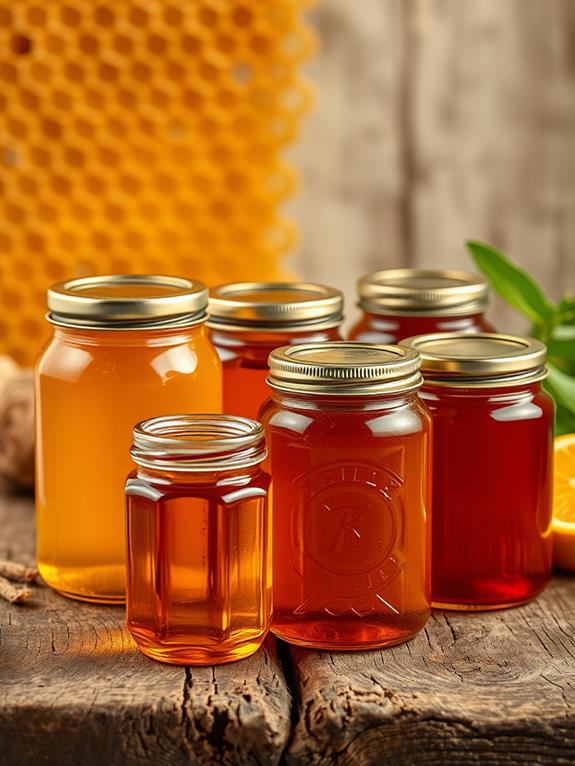
You might've heard some worrying rumors about dark honey's safety, but it's time to set the record straight. While proper storage is essential for maintaining honey's quality and safety, most claims about dark honey's toxicity are unfounded myths. In fact, similar to how nutritional products like Nutritional Yeast offer health benefits, dark honey is rich in antioxidants and can contribute positively to your diet. Understanding the facts about dark honey's composition and storage requirements will help you enjoy this nutritious food confidently and safely.
Toxicity Myths Debunked
Despite its rich color and intense flavor, dark honey has been the subject of various safety misconceptions. You might have heard claims that dark honey is toxic or harmful, but these assertions are largely unfounded. Let's debunk some common myths.
Firstly, the darkness of honey doesn't indicate toxicity. The color variation is primarily due to the floral source and mineral content. Darker honeys often come from sources like buckwheat or manuka, which are perfectly safe for consumption. In fact, they're often prized for their potential health benefits.
Another myth suggests that dark honey contains higher levels of harmful compounds. While it's true that darker honeys may have more antioxidants and minerals, these aren't detrimental to your health. On the contrary, they can contribute to the honey's nutritional value.
Some misconceptions stem from confusion with "mad honey," a rare type produced from rhododendron nectar. This specific honey can cause toxicity, but it's not related to typical dark honey you'll find in stores. Commercial dark honey undergoes quality control measures to guarantee safety.
In essence, dark honey's safety concerns are largely exaggerated. When purchased from reputable sources, it's as safe as lighter varieties.
Proper Storage Practices
Proper storage practices play an essential role in maintaining the safety and quality of dark honey. You'll want to keep your honey in an airtight container to prevent moisture absorption and contamination. Store it in a cool, dry place away from direct sunlight, as heat and light can degrade its quality over time. Avoid refrigerating honey, as this can cause crystallization and alter its texture.
When handling dark honey, always use clean utensils to prevent introducing bacteria or other contaminants. If you notice any signs of fermentation, such as bubbles or a sour smell, it's best to discard the honey. While honey doesn't technically expire due to its low moisture content and natural antibacterial properties, it can still deteriorate in quality if not stored appropriately.
To maximize shelf life, consider using glass containers instead of plastic, as they're less permeable to air and moisture. If your honey crystallizes, don't worry – this is a natural process and doesn't indicate spoilage. Simply place the container in warm water to liquefy it. By following these storage practices, you'll guarantee your dark honey remains safe and delicious for an extended period.
Processing and Storage Impact
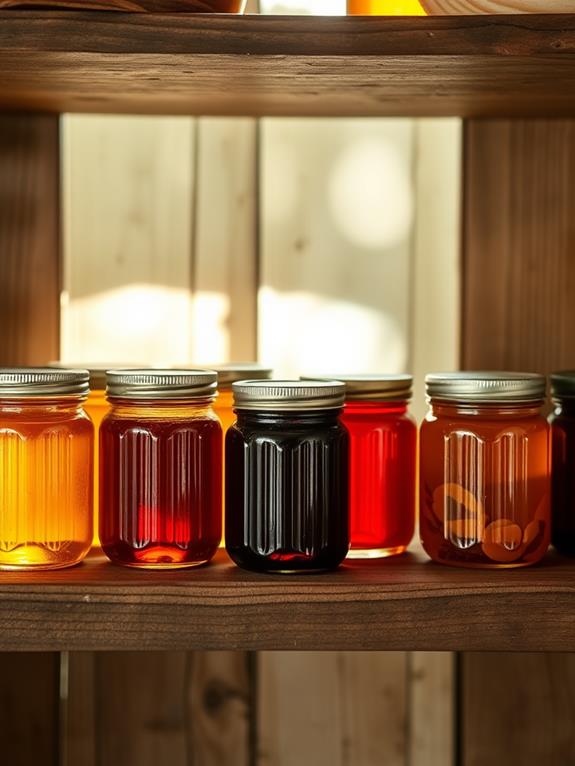
Processing and storage methods greatly influence the safety of dark honey. When you're reflecting on dark honey, it's essential to understand how these factors can affect its quality and safety. Proper processing guarantees that harmful bacteria and contaminants are removed, while appropriate storage prevents the growth of microorganisms and preserves the honey's natural properties. Additionally, dark honey can offer unique nutritional benefits, reminiscent of squid ink's nutritional profile and benefits. Here are key points to take into account regarding processing and storage:
- Raw vs. pasteurized honey
- Temperature control during storage
- Moisture content and crystallization
- Container materials and sealing
- Shelf life and expiration dates
The way honey is processed can impact its color, flavor, and nutritional value. Pasteurization, for instance, kills potential pathogens but may also destroy beneficial enzymes. You'll want to store your dark honey in a cool, dry place to maintain its quality. Avoid exposing it to high temperatures or humidity, as these conditions can lead to fermentation or spoilage. It's also important to use airtight containers to prevent moisture absorption, which can increase the risk of bacterial growth. By understanding these factors, you can guarantee that your dark honey remains safe and delicious for an extended period.
Identifying Quality Dark Honey
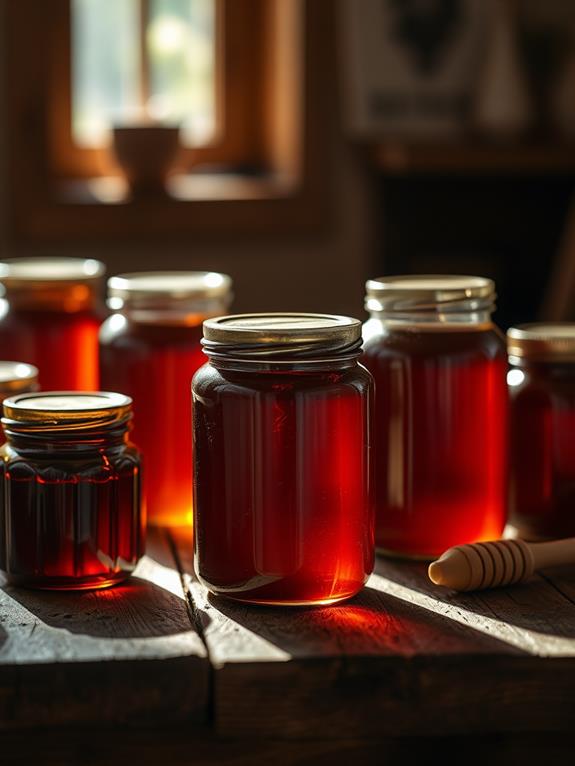
Three key factors can help you identify quality dark honey: color, consistency, and aroma. When evaluating color, look for a deep, rich amber to mahogany hue. High-quality dark honey should have a uniform color without any cloudiness or separation. The consistency should be smooth and thick, flowing slowly when you tilt the jar. If it's too runny, it might be adulterated or improperly processed.
Like the flavor profiles in coffee, good dark honey should have a complex character that enhances its taste. Pay attention to the aroma, which should be strong and complex. Quality dark honey often has notes of molasses, caramel, or dried fruits. Avoid honey with off-putting or artificial scents. When tasting, expect a bold, intense flavor that lingers on your palate. Look for certifications or labels indicating raw, unfiltered, or organic production methods.
To guarantee you're getting genuine dark honey, check the ingredient list. It should contain only honey, without added sugars or preservatives. Be wary of products labeled as "honey blend" or "honey syrup," as these may contain additives. Finally, consider the source and packaging. Reputable brands often provide information about the honey's origin and harvesting practices, helping you make an informed decision.
Incorporating Dark Honey Safely
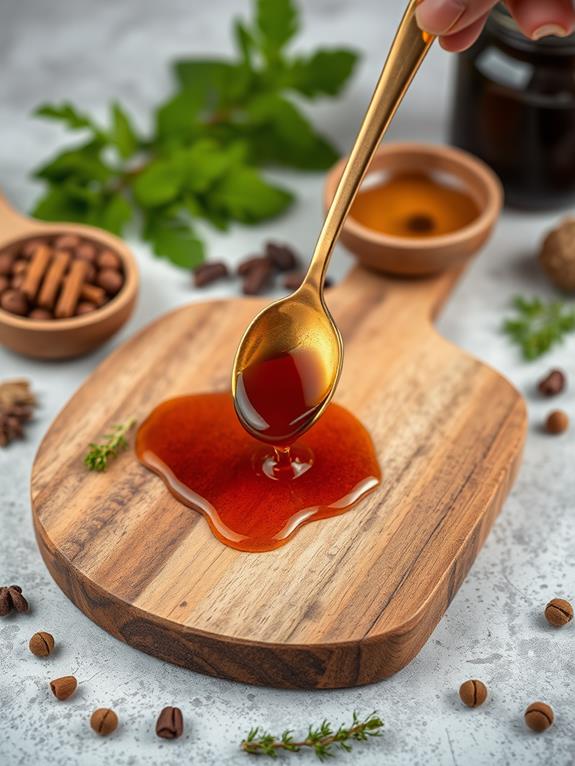
Incorporating dark honey safely into your diet involves several key considerations. First, verify you're using genuine dark honey from a reputable source. While dark honey is generally safe, it's vital to be aware of potential risks, especially for certain groups. One should also be cautious about the environmental impact of honey production, similar to the concerns surrounding palm oil, which is present in many products and has significant implications for biodiversity.
- Infants under 12 months should never consume honey due to botulism risk
- Diabetics should monitor their intake due to high sugar content
- Those with pollen allergies may experience reactions
- People with compromised immune systems should consult a doctor first
- Pregnant women should verify the honey is pasteurized
When using dark honey, start with small amounts to gauge your body's reaction. It's a potent sweetener, so a little goes a long way. Replace refined sugars with dark honey in recipes, but remember it's still high in calories. For ideal health benefits, consume it raw and unheated to preserve its nutrients and enzymes.
Always store your dark honey properly in a cool, dry place to prevent fermentation. If crystallization occurs, it's a natural process and doesn't indicate spoilage. Gently warm the honey to restore its liquid state. By following these guidelines, you'll safely enjoy the unique flavor and potential health benefits of dark honey.
Frequently Asked Questions
Can Dark Honey Be Used in Baking and Cooking?
Yes, you can definitely use dark honey in baking and cooking. It's a versatile ingredient that adds depth and richness to your dishes. You'll find it works well in both sweet and savory recipes. Use it to sweeten cakes, cookies, and breads, or as a glaze for meats. Dark honey's robust flavor pairs nicely with bold spices and can enhance sauces and marinades. Remember, it's slightly sweeter than regular honey, so you might need to adjust your recipe accordingly.
Does Dark Honey Crystallize Faster Than Light Honey?
You might think all honey crystallizes at the same rate, but that's not the case. Dark honey actually crystallizes more slowly than light honey. This is because dark honey typically contains more fructose, which crystallizes slower than glucose. Factors like temperature and moisture content also affect crystallization speed. You'll notice that light, raw honey tends to form crystals faster, while darker varieties, such as manuka or buckwheat honey, remain liquid longer.
Is Dark Honey More Expensive Than Regular Honey?
Generally, dark honey is more expensive than regular honey. You'll find it costs more due to its rarity and production process. Dark honey often comes from specific floral sources, like buckwheat or manuka, which are less common. It's also prized for its stronger flavor and potential health benefits. The higher price reflects these factors, as well as increased demand from consumers seeking unique honey varieties. However, prices can vary depending on the source, brand, and location where you're purchasing.
Can Dark Honey Help With Seasonal Allergies?
You might find dark honey helpful for seasonal allergies, but the evidence is mixed. Some believe that consuming local honey exposes you to small amounts of pollen, potentially building your immunity. However, scientific studies haven't conclusively proven this effect. If you're considering dark honey for allergies, it's best to consult with your doctor first. They can advise you on whether it's a suitable option for your specific situation and how to incorporate it safely into your allergy management plan.
How Does the Taste of Dark Honey Compare to Light Honey?
You'll notice that dark honey generally has a more robust, intense flavor compared to light honey. It's often described as having a richer, more complex taste profile with notes of molasses, caramel, or even malt. The flavor can vary depending on the flower source. Light honey, in contrast, tends to be milder and sweeter. Your taste preferences will determine which you enjoy more, but many people appreciate dark honey's bold, distinctive character in both culinary applications and as a standalone treat.





